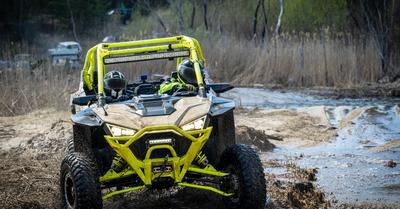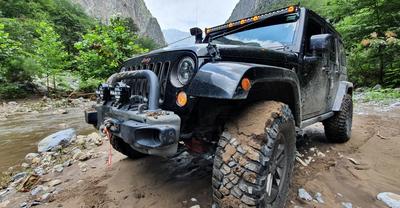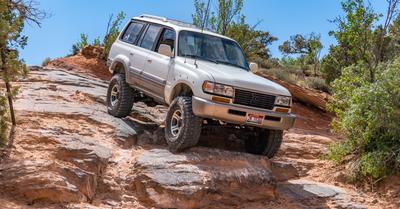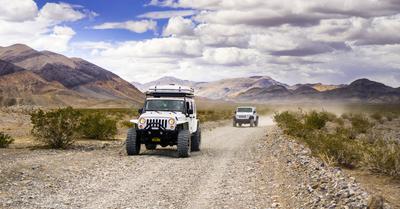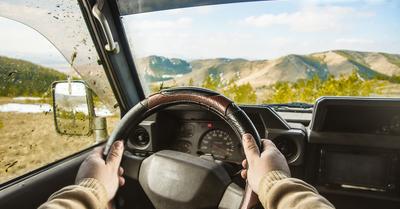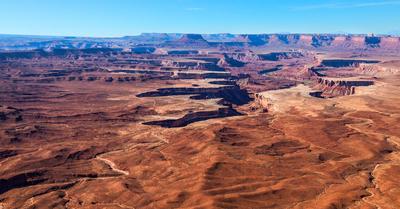Explore the rugged world of off-road vehicles, from powerful ATVs to versatile dirt bikes. Which type suits you best?
Different Types Of Off-Road Vehicles are All-Terrain Vehicle (ATV), Utility Terrain Vehicle (UTV), Dirt Bike, Dune Buggy, 4x4s, Side-by-Side (SxS), and Motocross Bike. These robust options excel in various terrains, offering power, agility, and adventure.
I've tackled some of the wildest terrains you can imagine. It's more than just a hobby; it's about pushing limits and embracing adventure. When it comes to conquering rough paths, I've learned it's all about skill, instinct, and the right mindset. I'll share insights and tips that only come from years of dust, mud, and exhilarating experiences!
Key Takeaways
- Off-road vehicles come in varied forms, from heavy-duty trucks to nimble dirt bikes.
- Off-road vehicles are designed to handle rugged terrains and with various preferences.
- ATVs, UTVs, dirt bikes, and dune buggies are some popular types of off-road vehicles.
- Your vehicle should match the specific activity and type of terrain being navigated.
This article may contain affiliate links where we earn a commission from qualifying purchases.
Types of Off-Road Vehicles
Off-road driving is an adventurous pursuit that demands the right equipment. When you leave the paved streets behind, you need a vehicle capable of tackling the unpredictable and rough terrain that lies ahead.
In the world of off-road vehicles, choices range from rugged SUVs built for durability and power to specialized motorbikes that offer agility and speed. Utility task vehicles such as the Jeep Wrangler and Ford Bronco are icons of the genre, offering high ground clearance and four-wheel drive systems built for diverse landscapes.
At the same time, dirt bikes provide a different kind of thrill, tailored for narrow challenging trails and challenging conditions. Each off-road vehicle category is designed with a distinct purpose in mind, ensuring you can find the right fit for your off-roading adventures.
Here’s a table comparing the features of the types of off-road vehicles:
1. All-Terrain Vehicle (ATV)
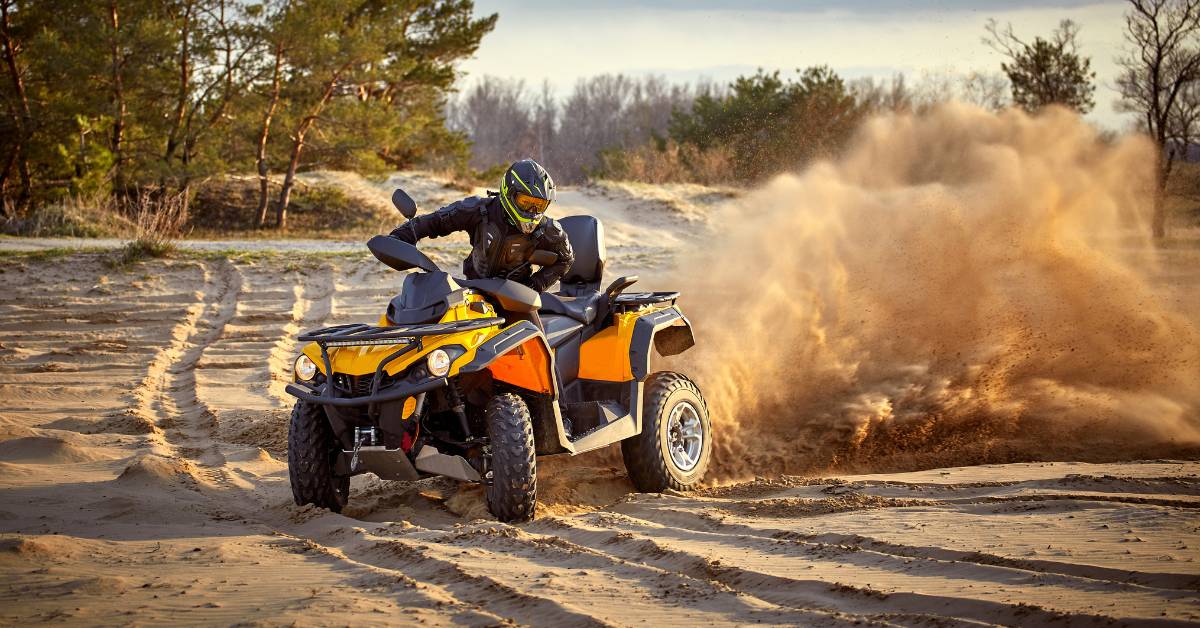
ATV
An All-Terrain Vehicle (ATV) is a versatile, rugged off-road vehicle designed to tackle a variety of terrain and tasks. They are equipped to handle diverse environments, from sandy dunes and mud patches to narrow trails and more challenging terrain. ATVs are commonly referred to as four-wheelers or quads due to their four-wheel and robust build.
Top Brands
- Polaris: A well-known manufacturer of off-road vehicles, Polaris offers an extensive range of ATVs, including sport and recreational/utility models, with features such as powerful engines, advanced suspension systems, and high ground clearance.
- Honda: Honda is recognized for its reliable and diverse lineup of ATVs, including their FourTrax series. These vehicles are built with a focus on quality, maneuverability, and performance to help riders traverse off-road terrain.
- Can-Am: As a part of BRP, Can-Am ATVs are designed with an emphasis on performance, reliability, and innovation. Their vehicles offer impressive power, advanced suspension systems, and ergonomic seating arrangements for a comfortable yet thrilling off-roading experience.
- Yamaha: Yamaha's ATV lineup consists of vehicles with a reputation for durability, performance, and handling. Featuring a range of models for both work and play, Yamaha's ATVs are suitable for tackling various off-road environments.
- Suzuki: With a history in off-road motorsports, Suzuki offers a range of ATVs known for their agility and control. From sports quads to utility ATVs, Suzuki provides riders with high-quality options for various purposes and terrains.
2. Utility Terrain Vehicle (UTV)
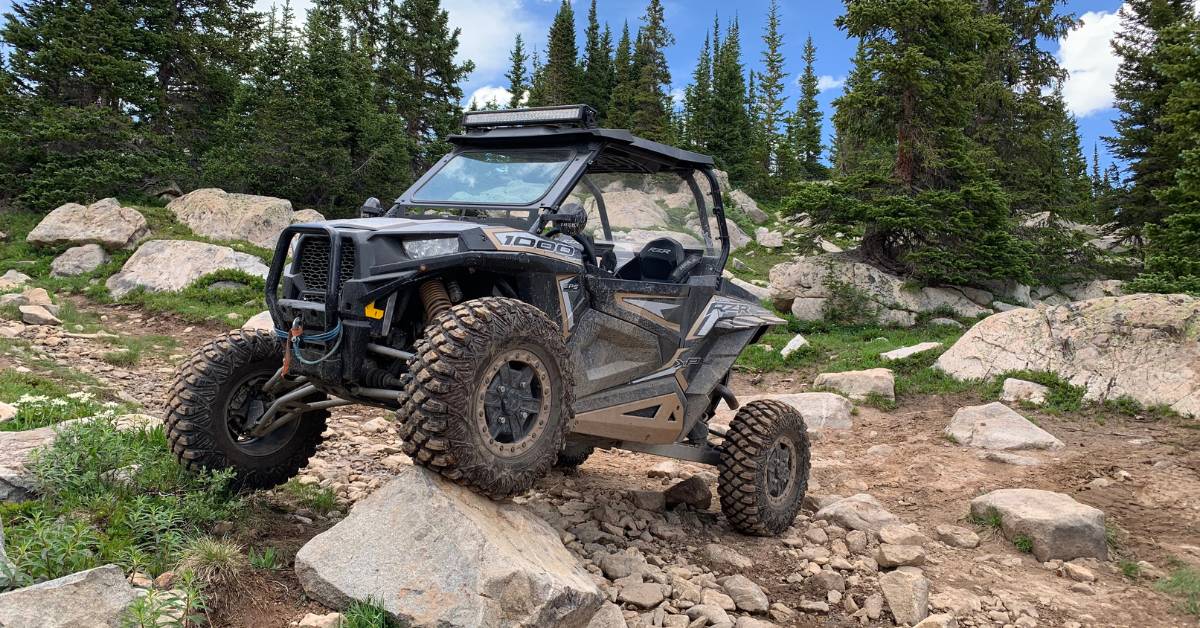
UTV
A Utility Terrain Vehicle (UTV) is a popular off-road vehicle designed for a wide range of tasks and recreational activities. Also known as utility task vehicles or side-by-side vehicles, UTVs are known for their versatility. They are equipped for off-roading adventures on challenging terrains, as well as for handling work-related tasks on farms and ranches.
Top Brands
- Polaris - This Polaris UTV brand offers a wide range of UTVs designed specifically for different off-road terrains and purposes. Known for their RZR Sport Side-by-Side and GENERAL Crossover Side-by-Side models, Polaris provides off-roading enthusiasts with high-quality vehicles that can handle various challenging terrains.
- Can-Am - Can-Am is another leading brand in the off-road industry. They offer a comprehensive lineup of UTVs, including their popular Maverick and Defender models, which have established a reputation for performance, reliability, and innovation.
- Honda - Honda is a well-known name in the off-road world with their de Colpster 1000X and Pioneer 1000 models. Honda's UTVs are designed to provide both comfort and performance in off-road environments, making them a popular choice for trail riding and work tasks alike.
- Kawasaki - Known for their rugged, dependable UTVs, Kawasaki offers models like the MULE PRO and Teryx that boast powerful engines, ample cargo capacity, and innovative features designed to optimize off-roading safety and comfort.
- Yamaha - Yamaha offers a range of off-road vehicles, including their Viking and Wolverine UTVs, which are designed for versatility and durability. These vehicles are engineered for incredible off-road terrain capabilities while also being suited for work and recreational purposes.
3. Dirt Bike

Dirt Bike
Dirt bikes are off-road motorcycles designed specifically for riding on rough terrain, mud patches, and sandy dunes. They are typically lighter than street-legal motorcycles, featuring knobby tires for better traction and long travel suspension for tackling challenging terrain.
Dirt bikes are popular among off-roading enthusiasts who love trail riding and want a vehicle that can handle the difficult-to-reach parts of the environment.
Top Brands
- Honda: Honda is one of the leading dirt bike and motocross bike manufacturers in the world. Known for their reliability and performance, Honda offers a wide range of dirt bikes catering to various skill levels and off-roading needs.
- Kawasaki: This Japanese brand is known for its performance-oriented dirt bikes that are popular among off-road racers and trail riders alike. Kawasaki's lineup of dirt bikes includes motocross and enduro models, catering to various styles of off-roading.
- KTM: Austrian manufacturer KTM is famous for producing high-quality off-road and motocross bikes. With a focus on performance, KTM dirt bikes are equipped with top-notch components and advanced technologies, making them favorites among professional racers and off-roading enthusiasts.
- Husqvarna: Another European brand, Husqvarna, is well-known in the dirt bike and motocross world. They offer a range of off-road motorcycles that cater to various riding styles and preferences. Known for their innovative designs and cutting-edge features, Husqvarna dirt bikes are sought after by many off-roading fans.
- Yamaha: Yamaha is a Japanese brand with a long history of producing top-quality dirt bikes and off-road motorcycles. Featuring advanced technology and reliable performance, Yamaha dirt bikes are suitable for both professional racing and casual off-roading adventures.
Below is a comparison table of the top dirt bike brands:
4. Dune Buggy
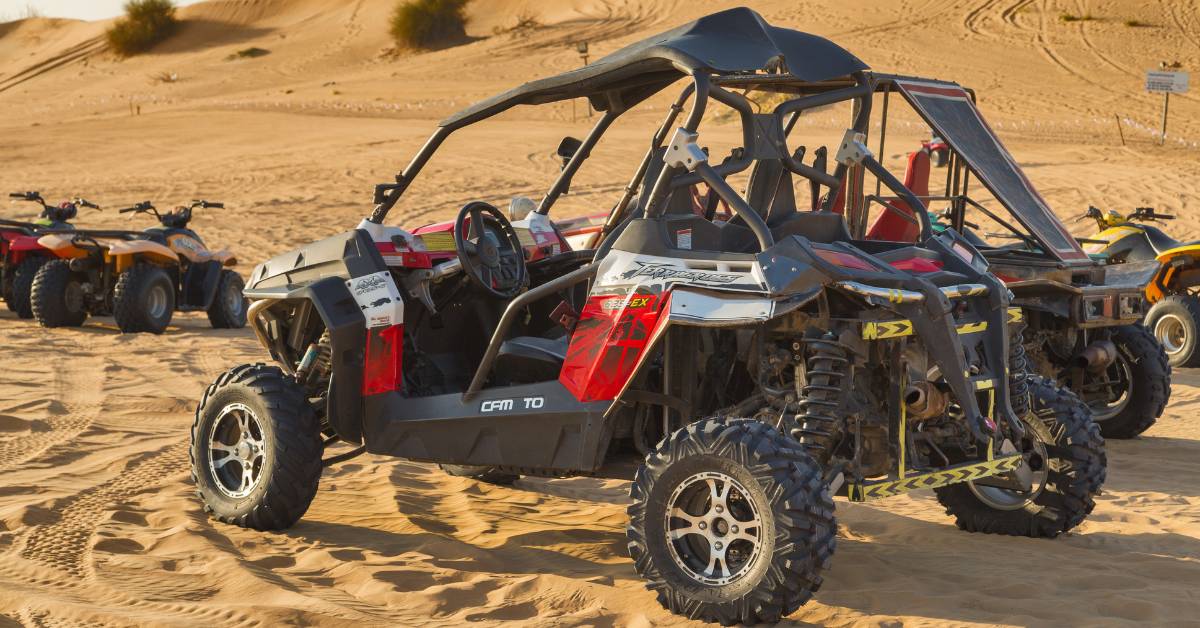
Dune Buggy
Dune buggies are a remarkable type of off-road vehicle that is designed explicitly for sandy conditions. With their wide tires and long travel suspension, dune buggies can easily take on the challenges of a desert environment.
They're perfect for those with a passion for off-roading and sandy adventures. In this section, we'll cover some of the top brands producing high-quality dune buggies.
Top Brands
- Polaris: A well-known brand in the off-road vehicle industry, Polaris offers the RZR XP Turbo, a high-performance dune buggy with incredible off-road capabilities, including a powerful engine and a comfortable interior.
- Can-Am: Another reputable brand, Can-Am, is known for the Maverick X3 X rs Turbo RR, a high-performance dune buggy that is perfect for maneuvering through rugged terrain with ease.
- Drakart: Drakart specializes in the production of off-road vehicles such as the Intimidator, a top-notch dune buggy with a lightweight design and impressive suspension system to handle challenging terrains.
- Tatum: Among the off-road vehicle enthusiasts, Tatum is famous for its Dragon Sand Car. It is specifically designed for off-road excursions with exceptional performance and an eye-catching design.
- Meyers Manx: The Meyers Manx is a classic dune buggy that has its roots in the original off-road vehicles, being an off-road refit of the iconic Volkswagen Beetle. Its unique design and simplicity continue to make it a popular choice for adventurous off-roaders.
5. 4x4s
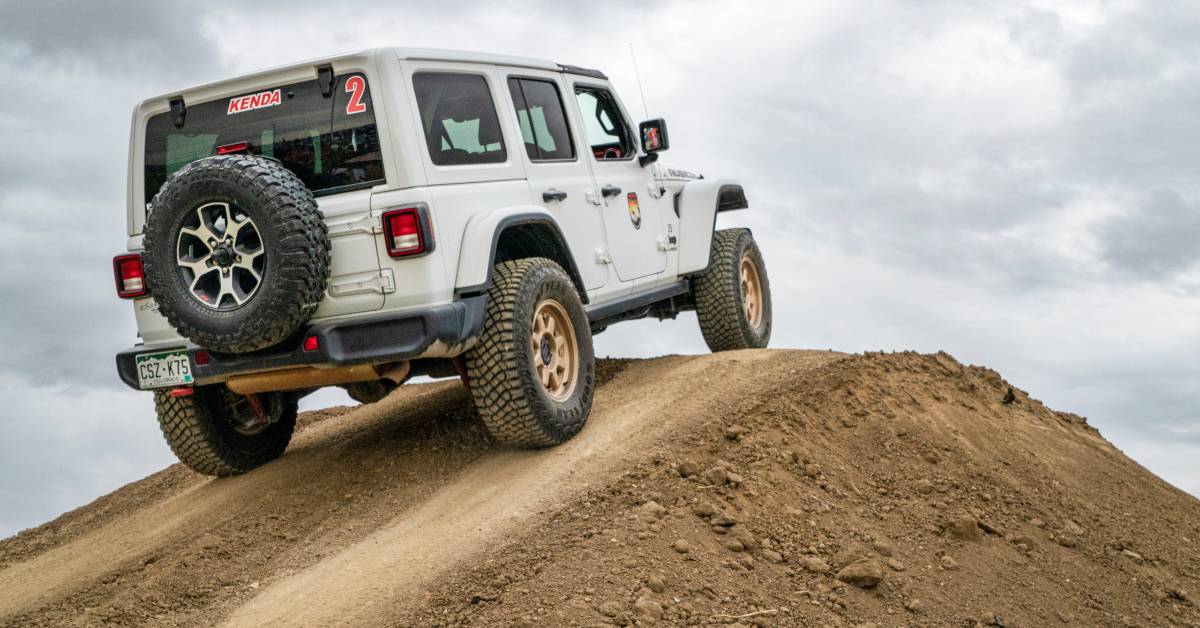
4x4
Off-roading vehicles are designed to traverse the challenging terrains of an off-road environment and provide an adrenaline-pumping experience for adventurous drivers. Among the wide array of types of off-road vehicles available, 4x4s are known for their rugged, capable nature and superior off-road handling.
Top Brands
- Jeep - Perhaps the most iconic brand in the 4x4 world, Jeep has been synonymous with off-road vehicles since the birth of the original military Jeep in the 1940s. Today, the modern lineup of Jeeps includes popular models such as the Jeep Wrangler, the ultimate off-roader with its powerful performance, high ground clearance (thanks to its huge four wheels), and excellent articulation.
- Ford - Known for producing reliable trucks and SUVs, Ford has made its mark in the off-road vehicle market with models like the Ford Bronco. This revived classic boasts impressive off-road capability, including locking differentials for better traction and a terrain management system to tackle various off-road environments.
- Land Rover - With a rich heritage in off-roading adventures, Land Rover has been producing rugged vehicles capable of handling tough terrains for decades. The Land Rover Defender is a noteworthy example, featuring a well-rounded mix of off-road prowess, comfort, and modern technology.
- Toyota - Toyota’s off-road offerings include the legendary Land Cruiser, known for its durability, reliability, and off-road performance. Its locking differentials and advanced suspension system make it a top choice for those looking to conquer challenging terrains and trails.
- Jeep Gladiator - A recent addition to Jeep's lineup, the Jeep Gladiator provides the perfect blend of Jeep's off-road pedigree and the utility of a pickup truck. With impressive off-road capability and an available front-facing off-road camera, the Gladiator is ready to tackle any off-roading adventure.
6. Side-by-Side (SxS)
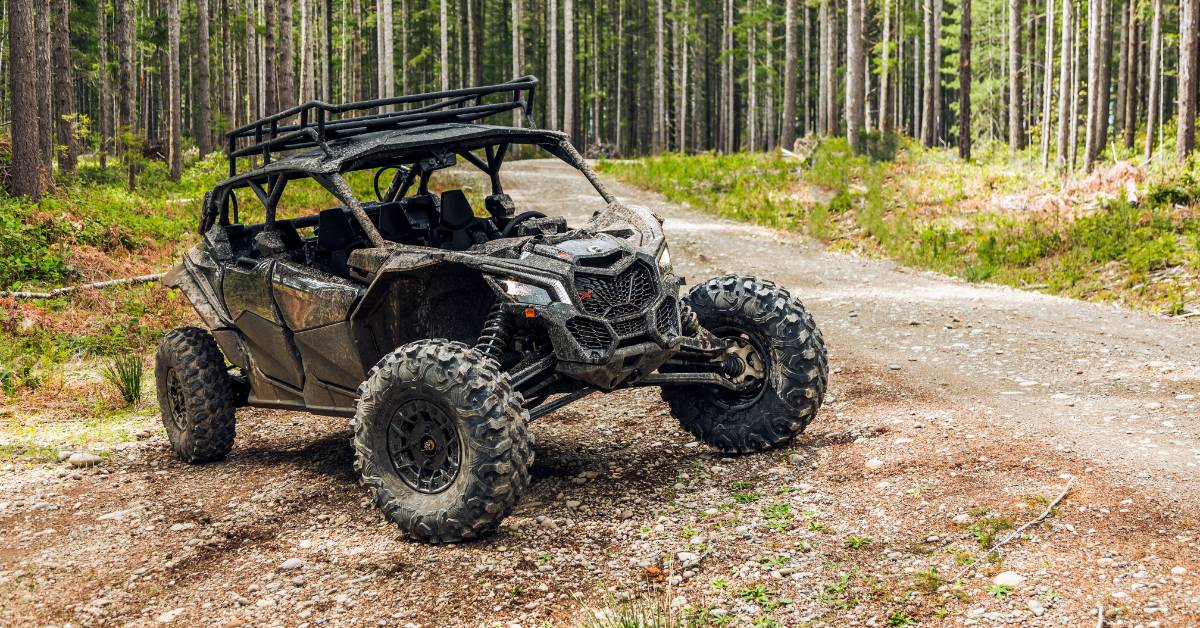
Side-by-Side (SxS)
A side-by-side (SxS) is a type of off-highway vehicle that features two seats and a steering wheel and is equipped with rollover protection like a roll bar or cage. These vehicles come in various designs and are built for off-road enthusiasts who enjoy trail riding and other off-roading adventures.
Accessories for these vehicles enhance their off-road capabilities and provide safety and comfort to riders.
Top Brands
- Polaris - Polaris is a popular brand for SxS vehicles, offering a wide range of off-road vehicles, such as their RZR Sport Side-by-Side and GENERAL Crossover Side-by-Side. Their vehicles are designed for various terrains like trails, deserts, dunes, rock crawling, and mudding.
- Can-Am - Another renowned brand in the off-road industry is Can-Am. They offer a variety of SxS vehicles with their Maverick and Commander lineups. These vehicles are known for their high ground clearance, powerful engines, and trail-riding capabilities.
- Honda - Honda's off-road vehicle lineup includes the Pioneer series of side-by-side vehicles. They are well-suited for off-roading adventures with their durable build quality, focus on safety features and powerful engines.
- Yamaha - Yamaha is a brand known for its range of off-road vehicles, including the Viking and Wolverine SxS models. They specialize in offering vehicles that perform well in challenging terrain and are perfect for off-roading enthusiasts.
- Kawasaki - Kawasaki offers the Teryx and Mule lineups of SxS vehicles, designed for both recreational use and utility purposes. Their vehicles are known for their rugged terrain capabilities and reliability.
Here’s a table comparing the best side-by-side off-road vehicle types:
7. Motocross Bike
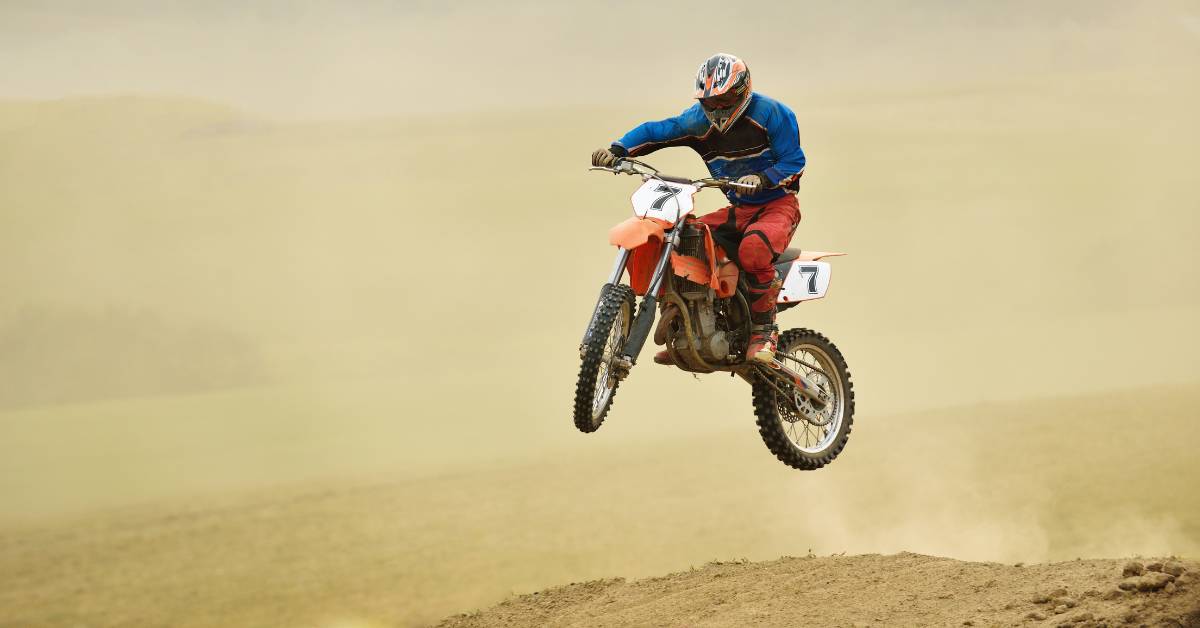
Motocross Bike
Motocross bikes are off-road motorcycles specifically designed for racing on challenging terrains such as dirt tracks, hilly areas, and uneven surfaces. They provide excellent traction, stability, and agility. These dirt bikes are built to withstand rigorous conditions while maintaining a dynamic performance on the tracks.
The motocross scene is dominated by a few top brands that consistently produce high-quality bikes to enhance the overall off-road experience.
Top Brands
- Honda: Honda is known for producing reliable and powerful dirt bikes. Their lineup includes the popular CRF series, which offers versatility and performance for both novice and experienced riders. The Honda CRF250R is a top choice for motocross enthusiasts looking to conquer challenging terrains with ease.
- Kawasaki: Kawasaki boasts a range of off-road bikes that are designed to excel on motocross tracks. Notably, their KX models, such as the KX450F and KX250F, are highly regarded by the motocross community for their agility, reliability, and power.
- KTM: KTM is a brand synonymous with high-performance dirt bikes. Their off-road lineup, including the popular SX and XC models, is built to perform exceptionally well on the tracks. With an impressive balance of power, weight, and handling, KTM dirt bikes are a top choice for motocross riders.
- Husqvarna: Originating in Sweden, Husqvarna is a brand that has a long history of producing high-quality off-road motorcycles. Their motocross bikes, such as the FC and TC models, are known for their lightweight construction, outstanding suspension performance, and excellent handling capabilities.
- Yamaha: Yamaha is a trusted brand in the motocross racing scene, with a range of off-road vehicles beloved by riders of all skill levels. The brand's YZ models, specifically the YZ250F and YZ450F, are recognized for their exceptional handling, performance, and durability.
Here’s a table comparing the best brands of motocross bikes:
Tips for Responsible and Sustainable Off-Roading Adventures
Off-roading is an exhilarating way to explore the great outdoors, but it comes with a responsibility to protect our natural landscapes. Here are some key tips for responsible and sustainable trail adventures.
1. Tread Lightly on the Trails
Responsible off-roaders understand the importance of leaving no trace. Stick to established trails to minimize soil erosion and damage to vegetation. Avoid creating new paths or disturbing wildlife habitats.
2. Know the Rules and Regulations
Before hitting the trails, familiarize yourself with local off-roading regulations and guidelines. Some areas may have restrictions on vehicle types, noise levels, and seasonal closures. Ignorance of the rules is not an excuse.
3. Pack It In, Pack It Out
Off-roaders should always practice the "pack it in, pack it out" principle. Ensure you carry out all trash and litter, leaving the trail and surrounding areas cleaner than you found them.
4. Respect Private Property
Respect private property boundaries and obtain proper permissions when necessary. Trespassing not only damages relationships with landowners but can also result in legal consequences.
5. Minimize Noise Pollution
Off-road vehicles can be loud, and excessive noise disrupts the tranquility of natural settings. Consider installing noise-reduction equipment or mufflers to be a courteous neighbor on the trail.
6. Yield the Right of Way
When encountering other trail users, such as hikers, bikers, or horseback riders, yield the right of way. Slow down, maintain a safe distance, and give them ample space to pass.
7. Stay Informed and Educate Others
Stay updated on the latest off-roading practices and encourage fellow enthusiasts to do the same. Promote responsible off-roading within your community and online forums.
8. Practice Safety First
Off-roading can be challenging, so prioritize safety at all times. Use proper safety gear, adhere to speed limits, and carry essential tools and emergency supplies.


